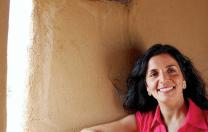In 1906, the U.S. government sent cavalry onto Hopi land in Arizona, “determined to send these people to boarding school,” says Gregory Schaaf, director of the Center for Indigenous Arts & Cultures in Santa Fe, New Mexico, and author of the multivolume American Indian Art Series. “Why? Underneath the Hopi land was a billion dollars’ worth of coal and oil, and a large aquifer. The U.S. government wanted to lease the rights to these resources to private companies and the Hopis wouldn’t sign the papers. So the job was to convince people to be loyal to the dominant culture—to produce some people who would sign. Send them to boarding schools.”
Indian boarding schools were blunt tools: they rank among the most heavy-handed institutions of socialization, indoctrination, and even brainwashing ever seen in North America. From the late 1800s through the twentieth century, scores of such schools throughout the western United States and Canada enrolled Indian students, generally against their will.
Scholars have described the residential boarding schools as “labor camps,” or experiments in modified slavery, run in the grueling, regimented manner of military schools. “My grandparents were taken from their homes and put in boarding schools,” says Daniel Moya, of the Pojoaque Pueblo outside Santa Fe. “Whenever they spoke their native language, they were beaten and made to eat soap.” Emotional and physical abuse was routine, and the curriculum explicitly indoctrinated students with the idea of the superiority of the dominant culture and the inferiority of native traditions.
Over the decades, the educational philosophy of the boarding schools did slowly evolve. Zia Pueblo, an Indian tribe about 20 miles southwest of Santa Fe, had no public schools of its own in the 1940s; all the Indian students went to boarding school, if they were in school at all. When tribal member Sofia Medina enrolled at St. Catherine’s Indian School in Santa Fe at age 12 in 1944, she knew only two English words, “yes,” and “no,” but the Roman Catholic nuns who ran the school did not punish the girls for speaking their native tongue. Tuition was $50 per year, and even that was a severe strain on Medina’s parents. She came home only once a year, in August.
St. Catherine’s was essentially a parochial school. “I was more or less brainwashed with the Catholic religion,” Medina says. “The nuns taught us that all our dances and traditions were ‘false gods.’ After I dropped out of school in the eleventh grade, I had no interest in the pueblo. My sister got mad at me because I would not participate in the dances.”
After Sofia married, her father-in-law explained native spiritual traditions to her—“Why the cornmeal, why the feathers,” she says. Now she goes to traditional ceremonies and shares her knowledge with younger Indians if they ask. “It is hard to understand, because Indians do not write about God on paper, like the white men do,” she says. “It is all up to each person, how they are going to take it.”
Sofia’s son Fred Medina attended two Indian boarding schools before graduating from Jemez Valley High School. He also completed technical studies at Southwest Indian Polytechnic Institute, and has a career as a lab technician. In the boarding schools he experienced, there was “no shaming of us for being Indians,” he says. “Wounded Knee [the 1973 protest by American Indian Movement activists at Wounded Knee, South Dakota] turned around a lot of things for all Indians. We recognized ourselves as not being second-class, but up there with everybody else.” But the native language has been slipping away. Though Zia Indians were fluent in their native tongue in the 1970s, Fred says Indian children today are bilingual only until about sixth grade, after which English wins out. Today’s youth live out the converse of his mother’s experience: “Now, kids know how to say only ‘yes’ or ‘no’ in the native language.”
Sofia’s granddaughter (and Fred’s niece) Kim Toribio enrolled at the highly regarded Santa Fe Indian School from seventh grade until eleventh grade (1983 through 1989), then completed her senior year at a public high school in Albuquerque. Kim came home to Zia every weekend from her boarding school. The staff was entirely Native American. “They cared about you,” she says. “They’d bend over backwards to get you scholarships,” and many in her graduating class of 23 went on to college. Kim herself earned an associate’s degree in business administration and now has an administrative job working with office automation software. “Santa Fe Indian was a good school,” she says. “I have no complaints.”








